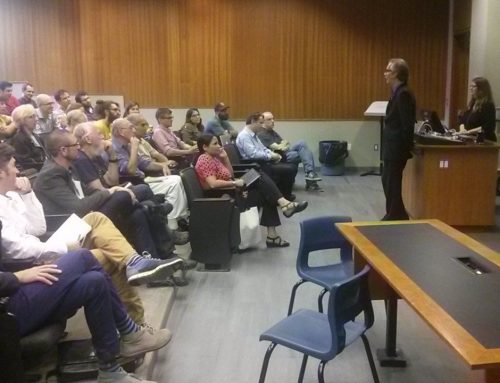by Dan Hicks
Why is the climate change debate so interminable? From the perspective of many scientists, we’ve had compelling data since the 1970s and more than enough reason to reduce greenhouse gas emissions since the 1980s. Today the IPCC will release the first part of their fifth Assessment Report. But no one really expects this document to settle the debate.
One very common explanation for the endlessness of the debate is that the public are ignorant. This might be because they haven’t learned much of anything at all about climate change; the historian of science Robert Proctor calls this “native state” ignorance. Or the public might be ignorant because a more-or-less organized group of people, the “climate skeptics” or “climate denialists,” are deliberately feeding them misinformation to protect fossil fuel interests; Proctor calls this “ignorance as a strategic ploy.”1
I agree that both kinds of ignorance play a role in drawing out the climate debate. But I don’t think it’s the complete explanation. So let me sketch a complementary one.
To begin, we need to understand how climate science works. There’s something that I call the “popular image” of climate science, according to which it’s supposed to work something like this:
- Scientists measure the temperature and notice that things have been getting warmer since the industrial revolution.
- Scientists infer that human greenhouse gas emissions are causing the warming trend.
- Scientists make predictions about the future, concluding that temperature will increase by a certain amount by the year 2100 if humans continue to emit greenhouse gases.
The popular image portrays climate science as nice, neat, and fairly easy-to-understand. The problem is that it’s radically false. A more accurate image is below. If you get a bit cross-eyed trying to understand how it works, don’t worry, that’s kind of my point. You can skip to the next paragraph.
- Scientists use statistical techniques to combine thermometer measurements (which only go back to about the mid-19th century) with physical measurements that indicate but don’t directly measure temperature (like the thickness of tree rings and pockets of air trapped in glaciers thousands of years ago).
- Scientists build thousands of computer simulations to model the interactions of various factors, from human greenhouse gas emissions to increased solar activity to the chemical composition of the oceans. All of these simulations involve assumptions and simplifications that make it possible for computers to actually produce results in a reasonable amount of time.
Some of these simulations compare combinations of major influences to the temperature data produced in step 1. It’s relatively easy to get the simulations that include human greenhouse gas emissions to statistically match the general trend of the temperature data. It’s much harder to get the simulations that don’t include human greenhouse gas emissions to match this general trend. So scientists infer that human greenhouse gas emissions are one of the major causes of the warming trend. And scientists don’t even try to get the simulations to match the temperature data exactly. - Once scientists have simulations that do a reasonably good job of matching the general trend in the past, they run the simulations forward to about the year 2100. Since the simulations don’t usually agree on these future projections, they’re aggregated using more statistical techniques.
In short, climate science relies on simplifying assumptions and complex statistical techniques. The conclusion that humans are responsible for climate change is based on evidence, but it’s not the easy inference that the public image suggests. Indeed, that last point is more general: climate science is not nice, neat, and easy-to-understand, as the popular image presents it.
This mismatch between the popular image and the complex reality gives sophisticated climate skeptics two kinds of crucial openings. First, skeptics can point to particular complicated and messy elements — weird assumptions in the statistics or computer simulations, or the complicated relationship between temperature data and the design of computer simulations. Second, skeptics can mimic parts of the climate science process in ways that will seem, to many non-scientists, to be about the same as what climate scientists are doing, while getting radically different conclusions.2
These skeptical arguments work on two levels. On the technical level, they assert that there are problems deep within the complexities of climate science. On the popular level, by pointing out that climate science isn’t living up to what it’s supposed to be — according to the popular image — they assert that the whole enterprise of climate science is a sham. It’s supposed to be nice and simple, but — skeptics suggest — that’s all just smoke and mirrors.
Climate scientists and activists give good responses to these arguments on the technical level. But they don’t deal well with the popular level — they don’t take on the popular image of climate science as nice, neat, and easy-to-understand. Indeed, their simplified explanations for non-scientific audiences often reinforce this image.3 And this, I think, is one major reason why skeptical arguments are so durable, and so why the climate debate continues with no end in sight.
Dan Hicks is a Post-Doctoral Fellow in the Rotman Institute of Philosophy.
Cross-posted at Je fais, donc je suis.
-
Proctor explains this distinction in the opening essay of the collection Agnotology, edited with Londa Schiebinger. That book also includes an essay on the use of ignorance as a strategic ploy in the climate debate by historians Naomi Oreskes and Eric Conway. ↩
-
For an example of the first, see here. For an example of the second, see here. ↩
-
For example, compare the “Basic” and “Intermediate” responses to climate skeptics here. ↩





